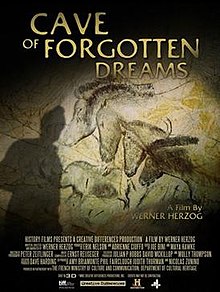Werner Herzog's Cave of Forgotten Dreams is an extraordinary film. If you're an artist or an archaeology nut, go and see it on the biggest screen you can manage, in 3D. Ignore the fact that it's repetitive, and ignore most of the bits when people are talking. It's worth it just for the incredible footage of prehistoric art from 30,000 years ago.
The artistic style of these ancient painters was unexpected. Egyptian and Babylonian art, some 25,000 years later, is highly stylized, with simple outlines and profile views. These images of horses, lions, and other animals are often fully shaded, with 3/4 views.
The 3D gives you a real sense of the shape of the rocks and how the paintings flow over them, and the camera gets in so close you can see every line, from the subtle shading on a horse's mouth to the fur on a bison's shaggy mane. It's more than you'd ever see if you went there, and you'll never be allowed inside the cave anyway because the environment is so fragile. It is a quite breathtaking cinematic experience.
So why the title of this piece?
I was already familiar with the cave paintings and the prehistory, and was mostly just absorbed in the imagery rather than listening to the narration. The one thing that really struck me was this little lady, who got a mention in passing.
She's the Venus of Hohle Fels, and at around 35,000 BC, she's the oldest piece of figurative art in the world. She's less than three inches high, she was found in 2008, and she's one of the most important milestones in human history.
She was carved from a mammoth tusk at about the time Homo sapiens and Homo neanderthalensis were jockeying for supremacy. Neanderthals, contrary to what we all believed when I grew up, were stronger and smarter than sapiens. They had bigger brains, and as far as we can tell, they had similar social organisation, similar weapons, and comparable technology. Yet the inferior sapiens - that's us - won.
So what was the difference? Well, the only thing archaeologists can point to is that Homo sapiens created art. He learned to make symbolic representations of his world. Which, apparently, paves the way for religion, stories, and a whole bunch of new forms of thinking. And just look at what the very first sculptors made - carvings of women with oversized breasts. An ancient fertility icon, or the prehistoric equivalent of Playboy? We don't know. We'll never know. But we do know that it's what made the difference between the winners and the losers in the struggle between two species for global supremacy.
So, archaeologically speaking at least, that's what makes us human. An appreciation of boobs.
Because otherwise, we'd all be Neanderthals.




No comments:
Post a Comment